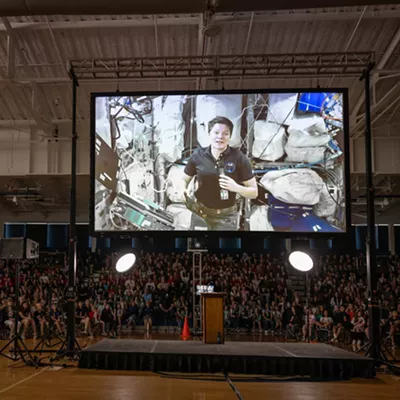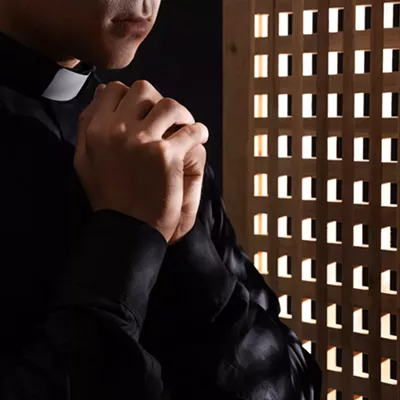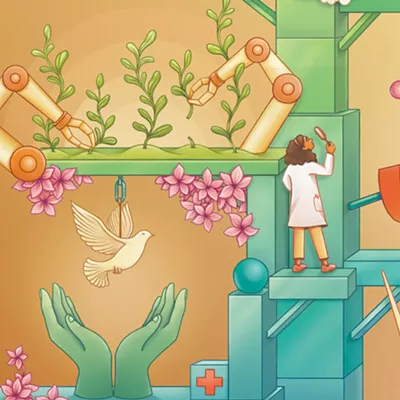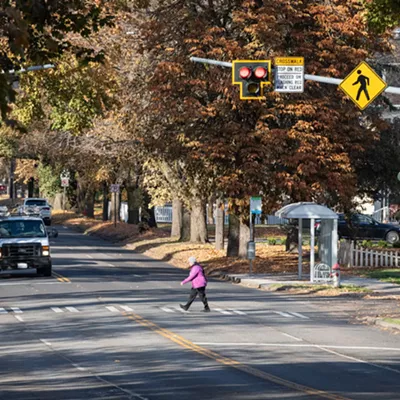The first thing Leonard Bernstein scrawled across his copy of Romeo and Juliet -- the source of Arthur Laurent's book of West Side Story -- was "an out-and-out plea for racial tolerance." For him, the essence was less about locating a soul mate than about finding a place where all of us, despite our tribal differences, might live in harmony and avoid senseless deaths.
Taking his cue from the original Broadway production of West Side Story (1957) and the movie (1961), Michael Weaver, the director of the current Coeur d'Alene Summer Theater version, has added some touches that underscore Bernstein's intent.
The movie, for example, reserves the lines "Somehow, somewhere, we'll find a new way of living" for Maria and Tony, when the Puerto Rican girl and the Polish-American boy fantasize about a private, idealized future together. The musical, however -- quite brilliantly -- had taken the same song and made of it a plea for racial harmony, a cry against intolerance. The script calls for an off-stage voice to sing the lines as nearly the entire cast, Hispanics paired up with whites, stand silently together -- a vision of what might be, if only we could all get along.
Weaver spotlights this moment by bringing on one of the Puerto Rican girls in the chorus (Amy Ross, as Rosalia) front and center. In one of the night's most moving sequences, she sings our yearning for peace. In another departure from the script, Weaver brings on the gang leaders, both Riff and Bernardo -- whom we've already seen killed in the knife-fight -- not only to reenact the rumble, but to deliver final fond farewells from beyond the grave. Dead brother kisses sister, best friends touch fists for the last time. By resurrecting the two ghosts, Weaver lays bare our sadness and embodies the price of violence.
West Side Story is now 45 years old, and with all its hipster lingo ("dig it!" and "Daddy-o"), it's showing its age. Compared to today's drive-bys and drug-dealing, the Jets and the Sharks seem merely quaint. But so what? It was just a different era. Yet even in a musical that represents knife fights with highly stylized, acrobatic dance moves, there has to be a sense of real danger. We witness three murders in this show, after all. The audience has to believe that any given Jet or Shark is capable of flipping open a switchblade and slitting a throat. Absolutely, we can dig how smooth these dancers are, Daddy-o -- but we're missing the sense that any moment now, the cracks in the pavement could be filled with blood.
The costuming doesn't always help. The unfortunate decision to put the Jets in khaki pants and blue letterman jackets seems more Tab Hunter than James Dean. The Jets come from homes, remember, with alcoholics and hookers. These kids have got to seem like street fighters who express their anger through dance, not like dancers throwing pretend punches.
Still, choreographer Christopher Moll's dance corps does more than just dance a little. The group choreography was consistently impressive, and Moll managed to add some flourishes to Jerome Robbins' original dance moves without slavishly copying them. The gangs' competitive dancing at the gym, for example, seemed more cutthroat than in other versions.
The play's pathos, of course, relies on the central couple, Tony and Maria. As Tony, Jadd Davis combines superior singing skills with less impressive acting. But oh, that voice. Davis belted out "Maria" so powerfully, so beautifully that the opening-night audience responded with a lengthy ovation. Tony dreams an impossible dream, and Davis hit some impossibly high notes. It was astounding. And yet, in a song about falling head-over-heels in love, Davis and Weaver have decided to plant Tony stock-still, hands gripping a steel railing for the song's duration. His rigid body language doesn't match the lyrics' exuberance, and the passion drains out of the scene. Elsewhere, Davis climbs ladders with care and restrains his screaming over injustice. But Tony's an athlete, and a bit reckless -- he started the Jets along with Riff, after all.
As Maria, Callie Cabe is a more compelling actor, even if her voice isn't as flamboyant as Davis'. During both the bridal-shop scenes and later, with Anita in "I Have a Love," we can feel that she really is impatient, impetuous, in love.
Some emotional climaxes, however, seem rushed and fall flat. At the dance, Tony and Maria just sort of walk on and start making goo-goo eyes at each other. Davis and Weaver under-emphasize the moments when Tony discovers that he has killed Bernardo or that Maria is "dead." Tony scampers out the bedroom window before Anita's discovery of the two lovers can fully register.
But there is still much to admire in this show: the contrapuntal singing in "Tonight"; the simple pathos of the pretend-wedding; the Puerto Rican men's neon shirts; Jim Thomas' stage presence as Det. Shrank, standing up to all these little punks; the convincing athleticism of both Moll as Riff and Mike Ericson as Bernardo.
Weaver's production ultimately focuses more on triumph than despair. After such tragedy, some hope: Maybe some day, the current CdA production seems to suggest, having discarded our petty prejudices, we'll find a new way of living. Somehow, somewhere.
















